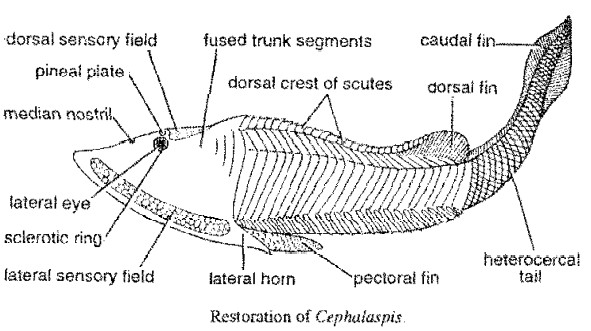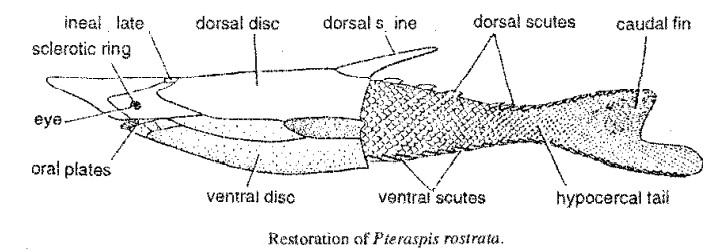OSTRACODERMS
Introduction
- The earliest known vertebrates to appear in fossil record were jawless primitive fishlike animals collectively known as the ostracoderms, and placed under the class Ostracodermi. They resembled the present day cyclostomes (lampreys and hagfishes) in many respects and together with them, constitute a special group of jawless vertebrates, the Agnatha.
Occurrence
- Ostracoderms were encountered first as fragmented fossils occurring in the rocks of late Cambrian and middle Ordovician periods, dating back approximately 5(X) million years. They were quite abundant during the upper Silurian and Devonian periods. Most of their fossils were preserved in the bottom sediments of freshwater streams. However, opinion is sharply divided as to whether their habitat was freshwater or marine.
Important Features
These primitive vertebrates were small to medium sized. Their body form was fishlike, usually flattened dorso-ventrally, with a huge head and gill region, a tapering but muscular trunk and some sort of tail fin. They had no jaws and no pectoral or pelvic fins but had only median fins. Remarkably these earliest vertebrates were very bony and heavily armoured. The head was encased in a solid shield made of broad bony dermal plates, while the rest of the body surrounded by a series of smaller plates often called dermal scales. This has led to their names ‘ostracoderms’, ‘armoured fishes’ or ‘bony skin’ (Gr., ostrakon, shell + derma, skin).
Why were they so heavily armoured ? It has been suggested that the heavy exoskeleton served as a protection against the giant scorpion-like arthropods, the eurypterids, which were dominant predators of Cambrian, Ordovician and Silurian periods. Later, when these enemies disappeared, the jawed descendants of ostracoderms also lost their heavy armour which only hindered rapid progress.
The ostracoderm head was rather unusual. Most kinds had a pair of large lateral eyes and a median pineal eye on top of head. A single median nostril was located anterior to pineal eye. Very little is known about ostracoderm internal anatomy. They had no axial endoskeleton or vertebrae. Mouth was ant ero ventral small and without jaws or teeth. Sensory fields on head were probably a part of the lateral line system. Judging by their flattened body and feeble fins, they were probably sluggish bottom dwellers and filter feeders, like most of the present day lower chordates. An internal ear with 2 semicircular canals was present.
Classification
All ostracoderm fossils have been generally put under a single class Ostracodermi. It is divided into 2 sub-classes and 5 orders, as follows :
Subclass I. Monorhina
A single, large, slit-like median nostril on top of head between eyes.
Order 1. Euphanerida :- Silurian, Represented by a single genus and species, Jamoytius kerwoodi, previously placed under order Anaspida by- Stenrio and Ritche (1960). Newth regarded it as ammocoet larva of ostracoderms, discovered in the silurian strata of England. About 18 cm long, fusiform, blunt-head and naked. Indications of two lateral and a median dorsal fin folds, notochord, and muscle myotomes like those of Branchiostoma. No gill-slits. Regarded as an ancestor of ostracoderms.
Order 2. Anaspida :- Silurian-Devonian. Body small about 15 cm long. Head naked or covered by a complex of small plates. Arrangement of scales was complicated. In the trunk region, scales were oriented in longitudinal rows. Mouth was terminal. Eyes laterally placed. Nostril, single median. Paired appendages were represented by a pair of pectoral spines. A series of spines was found in the mid-dorsal line of the trunk. An anal spine might have also been present. About 8 gill-slits were present in front of the pectoral spine in slanting fashion. Tail hypocercal (lower lobe larger). They were active swimmers. Birkenia. Lasanius, Ptemleps, Rhyncholcpis and Pharyngolepis.
Order 3. Osteostraci (Cephalaspida) :- Silurian-Devonian. A single piece head shield or carapace without sutures. Tail heterocercal (upper •lobe larger). A pair of palps behind the gills served like pectoral fins. Several pairs of gill slits. Sensory fields on head. Lateral eyes close together. Lampreys (Petromyzontiformes) probably were derived from. Osteostraci. Tail, heterocercal. Cephalaspis, Hemicyclaspis, Tremataspis, Kiaeraspis, Didymaspis, Benneviaspis etc.

Subclass II. Diplorhina
Two separate nasal openings, where known.
Orde r 1. Heterostraci (Pteraspida) :- Ordovician-Devonian, Body large, Head encased in a shield. Tail was laterally compressed, covered with small scales hypocercal. Mouth slit like aperture. Anterior portion of the snout is prolonged into rostrum. Lateral eyes widely separated. A single large gill-slit on each side. No signs of sensory organs. Lateral line was distinct. A backwardly directed dorsal spine projected upwards from the posterior part of cephalic shield. Entire trunk was found covered with ractangular scales. Hagfishes (Myxiniformes) were probably derived from Heterostraci. Pteraspis, Drepanaspis.
Order 2. Coelolepida :- Ordovician-Devonian. Body small (10 to 12 cm long) and fusiform or torpedo-like, Surface covered by numerous minute placoid-scale like denticles. Tail hypocercal or heterocercal. Lateral eyes widely apart. Broad flanges project antero-laterally from body. Phlebolepis, Lanarkia. Coelolepis

Affinities of Ostracoderms
The affinities of the ostracoderm fossils with each other have been much disputed. There is evidence to believe that ostracoderms were not all equally related and at least two district major groups are recognized : the cephalaspids and the pteraspids.
According to Lankester pteraspids were related to cephalaspids because both are jawless, have a large cephalic shield and occur in the same beds. On the other hand Prof. Eric Stensio (1927) believes that the pteraspids have given rise to myxinoids and the cephalaspids to lampreys. There is indeed little in common among the ostracoderm fossils except foi the absence of jaws Differences m the stupe ot then tails aie especially baffling. As White suggests, the earliest vertebrates had straight or diphycercal tails. From these evolved pteraspids with hypocercal tails, as well as cephalaspids with heterocercal tails. The modern cyclostomes have been probably evolved from the cephalaspids. But which ostracoderm group gave rise to the earliest gnathostomes is unknown.
The ostracoderms closely resemble the modern cyclostomes in :-
- absence of biting jaws
- structure of brain and cranial nerves
- similar auditory capsules
- unpaired olfactory organs
- pouch-like branchial sacs.
Stensio (1927) believes that cyclostomes have descended from ostracoderms by the evolution of a sucking mouth, loss of bony exoskeleton ami paired limbs and development of cartilage.
The fossil ostracoderms, as we find them, were specialized and products of a long evolutionary past. They probably evolved from unarmoured ancestors such as Jamoytius. They could not compete with the jawed fish that evolved in such diversity during Devonian and became extinct. Before extinction the ostracoderms gave rise to the first bony fishes, the placodenns, and the cartilaginous Chondrichthyes.
Biological Significance of Ostracoderms
- Ostracoderms are especially interesting because they represent the oldest known vertebrate fossils in the late Cambrian and Ordovician rocks dating back to nearly 500 million years. They are the remote ancestors of all the vertebrates including man.
- Microscopic examination of their fossilized bony tissues reveals a great complexity of structure, thereby implying that these vertebrates were far advanced and had undergone a considerable period of evolution before becoming fossilized.
- Lack of earlier vertebrate fossils shows that they had perhaps evolved in a habitat (fres[1]hwater?) which was inimical to fossilization. It is also likely that the earliest ancestors lacked hard skeletal materials, i.e., bone.
- They developed heavy bony armours perhaps for survival against the attacks of contemporary giant arachnid predators, the eurypterids. As these enemies disappeared, the descendants of ostracodermis, the cyclostomes, also lost the unwanted heavy armour which was a hinderance in rapid progression.
- The cartilage of cyclostomes and sharks and skates (Chondrichthyes) was previously considered a precursor to bone and more primitive. Since the ostracoderms had bony skeletons, the bone is now considered more primitive and the cartilage is interpreted as a degenerate condition.
Discover more from ZOOLOGYTALKS
Subscribe to get the latest posts sent to your email.

